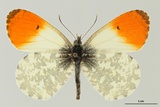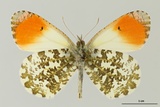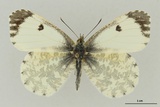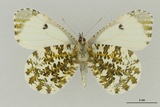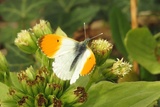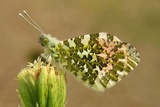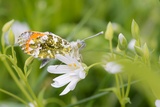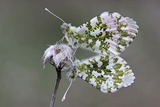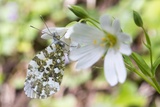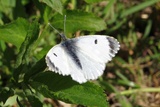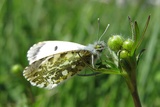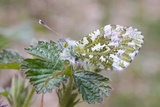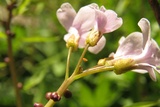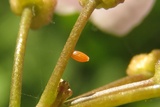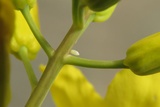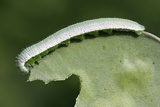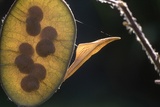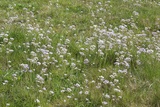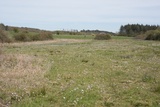Anthocharis cardamines (Linnaeus, 1758) Species
Last modified: Nov. 7, 2023, 9:37 a.m.
A common species of humid grasslands and forest edges, throughout Belgium.
Details
- Classification
- Family: Pieridae > Subfamily: Pierinae > Tribus: Anthocharini > Genus: Anthocharis > Species: Anthocharis cardamines
- Vernacular names
- Oranjetipje (NL), Orange-tip (EN), Aurore (FR), Aurorafalter (DE)
- First mention in Belgium
- De Sélys-Longchamps E. 1837. Catalogue des Lépidoptères ou Papillons de la Belgique, précédé du tableau des Libellulines de ce pays. — — : 1–29. On page 15 (as Pieris cardamines). view page
- Status
-
Native
Distribution
Imago
This is an easy to recognize species. The upperside is white with on the upperside of the front wing a dark crescent shaped discal spot and a black wing tip; in the males with the apical halve bright orange, in the females the black pattern bolder. The underside of the hindwing has a marbled white and green pattern (made up of mainly black & yellow scales).
Caterpillar
First instar caterpillars are pale yellowish with a dark head capsule, after moulting they turn greenish and in the final instars they get the typical greyish side stripe. They normally feed on the seed capsules of the larval foodplant, only exceptionally turning to leaves at the end of the larval feeding period. The larval stage lasts only two to three weeks.
Cocoon/pupa
The pupa is attached upright to a plant stem with a silk thread. The head part is elongated and pointed, the dorsal part is typically concave. The freshly formed pupa is greenish with a pale side stripe but after some days it turns to pale brownish, matching the colour of the dead plant material it will be staying in until next spring.
Bionomics
An overview of the bionomics of this species can be found on the Butterflies in the Benelux website.
Flight periods
The adults fly in one generation, from the end of March till the beginning of June, sometimes until early July in the highest parts of Belgium. The flight period is very weather dependent.
Observed on
- Host plant (species):
- Cardamine pratensis, Alliaria petiolata and Brassica oleracea
The larva lives on several species of Cruciferae, like Cardamine, Alliaria, Isatis, Sinapis, Brassica, Arabis, Lunaria, Biscutella and Hesperis.
Habitat
This species can be found in most regions of Belgium; mostly in or near damp meadows, near woodland edges or open lanes in woodlands. Sometimes also in gardens, especially in the presence of ornamental Lunaria annua. It is a mobile species however so it can be found outside these typical places as well.
